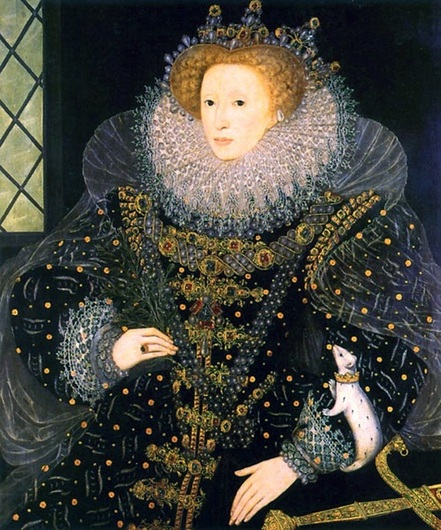|
The Breadcrumbs widget will appear here on the published site.
Say Hey to the Virgin Queen History is filled with excellent women of superb character who have overcome great obstacles to prove their worth. There are those who are noted in the public sphere and then there are some who only received recognition in their homes. With such an enormous pool of deserving candidates, it’s difficult to choose who I would consider to be my favorite woman in history. But, in light of all of the celebration in England over the birth of royal baby Prince George, my attentions go to Queen Elizabeth I of England (1558-1603 AD). Elizabeth I in her coronation robes. She was Regent of England and Ireland for 46 years during a time that became known as the Elizabethan Age. She was also known as the "Virgin Queen," "Gloriana," and the "Faerie Queen." Through her vast skills and unyielding faith, Elizabeth I led Britain from small island nation status to sustained prosperity and dominance (although some recent historians attribute this to plain old luck). Here is just a brief account of her life and deeds:  Queen Elizabeth I was the illegitimate daughter of King Henry VIII and Anne Boleyn, his second wife (whom he later had beheaded). In her youth she was known as Lady Elizabeth and spent much of her time reading and improving her knowledge of many topics as she could. She was a polyglot, fluent in English, Flemish, Welsh, Scottish, Irish, French and Greek (yeah, I know, right?). She loved music, horse riding, dancing, singing, and drama. It was during her reign that some of the most famous poets, writers, and scholars, such as William Shakespeare, flourished. Her ascension to the crown wasn’t an easy one. Her half-sister Queen Mary I, a.k.a. "Bloody Mary," locked her in the Tower of London and kept her imprisoned until she was exonerated from plotting Mary’s assassination. But, Elizabeth would not become queen until the death of Mary, who had no heirs. The crown then passed on to Elizabeth whose first order of business was to return England to Protestantism and oversaw the installment of the Church of England. This was a welcome relief to many after the cruel reign of Queen Mary who burned many Protestants at the stake for not adhering to Catholicism. Only as recently as 2013 did the British law change to allow Catholic monarchs. Elizabeth was also a fashionista with ostentatious tastes. She loved fancy and ornate dresses and accessories. Her dresses were adorned with jewels and she wore elaborate, showy collars. She was a trendsetter, but she never allowed anyone in her court to dress better than her! She would wear white makeup pancaked on her face to cover up the scars from the smallpox that she suffered in her youth. It gave her an otherworldly appearance. Elizabeth is one of the most prominent monarchs in British iconography. There were many paintings of her, which spawned a cult around her personality. Elizabeth never did marry or have children (which was a "bad" thing back then). She was said to have remained a virgin, although there was speculation that she may have carried on an affair with childhood friend Robert Dudley. She also had many royal suitors, but apparently pickin’s were slim and she decided she had rather marry the state of England. I admire her for withstanding the pressure to marry against her will, especially during a time and in a position where producing an heir was of utmost importance. She knew that the various Dukes and Princes vying for her attention might only be interested in her throne. And she was intent on keeping her status as it was, since the fact that if she had married, her husband would be king and have precedence over her. She really was quite clever. One of her many feats included leading her armies into victory to defeat the Spanish Armada and maintaining national sovereignty when many countries were looking to add England to their own real estate. It was her belief that God was on her side. "She is only a woman, only mistress of half an island," marveled Pope Sixtus V, "and yet she makes herself feared by Spain, by France, by the Empire, by all." As the English armies awaited the Spanish navy, she addressed her troops thus: . . . therefore I am come amongst you, as you see, at this time, not for my recreation and disport, but being resolved, in the midst and heat of the battle, to live and die amongst you all; to lay down for my God, and for my kingdom, and my people, my honour and my blood, even in the dust. I know I have the body but of a weak and feeble woman; but I have the heart and stomach of a king, and of a king of England too, and think foul scorn that Parma or Spain, or any prince of Europe, should dare to invade the borders of my realm . . ." “I may not be a lion, but I am a lion’s cub, and I have a lion’s heart.” Queen Elizabeth I also encouraged exploration of the New World, which first began during her rule. The state of Virginia was named after Elizabeth I as kudos to her “Virgin Queen” moniker. Her last few years were referred to as the “Golden Age of England” due to the stability that England experienced under her influence. Elizabeth’s popularity would soon fade but after her death, fascination with her picked up again. This was perhaps due to what some considered the abysmal leadership of her cousin King James VI of Scotland. In any case, Britain was on its way to becoming a great empire for many years to come. The rest, as we all know, is history.
CommentsComments are closed.
|
|










